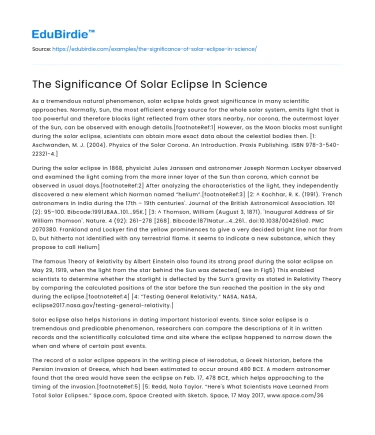As a tremendous natural phenomenon, solar eclipse holds great significance in many scientific approaches. Normally, Sun, the most efficient energy source for the whole solar system, emits light that is too powerful and therefore blocks light reflected from other stars nearby, nor corona, the outermost layer of the Sun, can be observed with enough details.[footnoteRef:1] However, as the Moon blocks most sunlight during the solar eclipse, scientists can obtain more exact data about the celestial bodies then. [1: Aschwanden, M. J. (2004). Physics of the Solar Corona. An Introduction. Praxis Publishing. ISBN 978-3-540-22321-4.]
During the solar eclipse in 1868, physicist Jules Janssen and astronomer Joseph Norman Lockyer observed and examined the light coming from the more inner layer of the Sun than corona, which cannot be observed in usual days.[footnoteRef:2] After analyzing the characteristics of the light, they independently discovered a new element which Norman named “helium”.[footnoteRef:3] [2: ^ Kochhar, R. K. (1991). 'French astronomers in India during the 17th – 19th centuries'. Journal of the British Astronomical Association. 101 (2): 95–100. Bibcode:1991JBAA..101...95K.] [3: ^ Thomson, William (August 3, 1871). 'Inaugural Address of Sir William Thomson'. Nature. 4 (92): 261–278 [268]. Bibcode:1871Natur...4..261.. doi:10.1038/004261a0. PMC 2070380. Frankland and Lockyer find the yellow prominences to give a very decided bright line not far from D, but hitherto not identified with any terrestrial flame. It seems to indicate a new substance, which they propose to call Helium]
Save your time!
We can take care of your essay
- Proper editing and formatting
- Free revision, title page, and bibliography
- Flexible prices and money-back guarantee
The famous Theory of Relativity by Albert Einstein also found its strong proof during the solar eclipse on May 29, 1919, when the light from the star behind the Sun was detected( see in Fig5) This enabled scientists to determine whether the starlight is deflected by the Sun’s gravity as stated in Relativity Theory by comparing the calculated positions of the star before the Sun reached the position in the sky and during the eclipse.[footnoteRef:4] [4: “Testing General Relativity.” NASA, NASA, eclipse2017.nasa.gov/testing-general-relativity.]
Solar eclipse also helps historians in dating important historical events. Since solar eclipse is a tremendous and predicable phenomenon, researchers can compare the descriptions of it in written records and the scientifically calculated time and site where the eclipse happened to narrow down the when and where of certain past events.
The record of a solar eclipse appears in the writing piece of Herodotus, a Greek historian, before the Persian invasion of Greece, which had been estimated to occur around 480 BCE. A modern astronomer found that the area would have seen the eclipse on Feb. 17, 478 BCE, which helps approaching to the timing of the invasion.[footnoteRef:5] [5: Redd, Nola Taylor. “Here's What Scientists Have Learned From Total Solar Eclipses.” Space.com, Space Created with Sketch. Space, 17 May 2017, www.space.com/36785-solar-eclipse-science-throughout-history.html.]






 Stuck on your essay?
Stuck on your essay?

